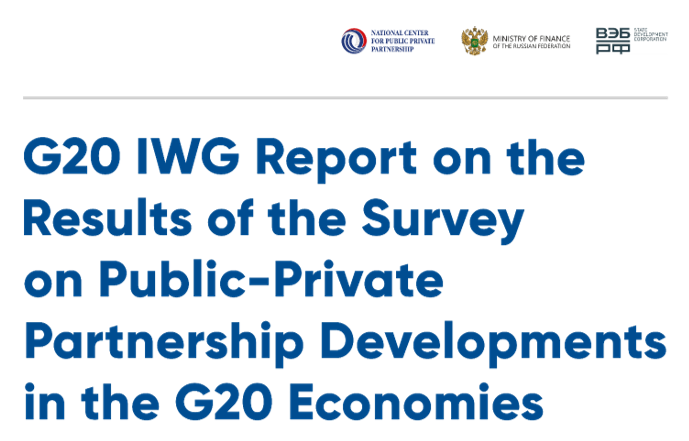956 results found
Featured results



More results
Global Infrastructure Outlook allows you to explore the annual infrastructure trends, needs and gaps up to 2040 for 7 sectors, 56 countries, 5 regions and the world total.


Project preparation is a critical enabler of infrastructure development and has been identified as a key pillar in the G20 s strategic roadmap to develop infrastructure as an asset class.

The paper discusses the state and the way forward for Africa's infrastructure, with a strong focus on quality infrastructure.

ICA’s flagship report, Infrastructure Financing Trends in Africa, shows trends of financing flows to infrastructure projects in Africa based on collected data from various stakeholders.

The iRAP case studies showcase activities that are saving lives and preventing serious injuries on roads.
The data presented in this report show that progress has been achieved in important areas such as legislation, vehicle standards and improving access to post-crash care. This progress has not, however, occurred at a pace fast enough to compensate for the rising population and rapid motorization of transport taking place in many parts of the world.


The third global report by Global Infrastructure Hub (GI Hub) and EDHEC Infrastructure Institute-Singapore reveals new investor insights on changing infrastructure markets.


In this report, Marsh & McLennan Insights, the Inter-American Development Bank and IDB Invest review the progress of the six largest infrastructure investment markets in the Latin American and the Caribbean region (the LAC6) in the recovery period following the Lava Jato investigation – the period from 2016 until the present. This report will evaluate private investment prospects in infrastructure based on transparency reforms and project pipeline initiatives offered by the region’s governments. The report will additionally outline a selection of key financing and risk solutions available to private investors to ensure project bankability in the region.

sustainABLE is a free online platform modelled on research jointly published by UNOPS and the University of Oxford-led Infrastructure Transitions Research Consortium. The extensive research explored the critical role of infrastructure in achieving the SDGs. The tool aims to advance the SDGs by promoting practical measures that encourage project sustainability across a broad range of sectors.

The Inclusive Design Standards bring together what LLDC consider the best of existing good practice guidance and consolidate this in a single benchmarking document to be used as a tool by design teams. This second edition of the London Legacy Development Corporation s (LLDC s) Inclusive Design Standards (IDS), originally published in March 2013, is evidence of the positive impact and continued legacy created by the enormous success of the Olympic and Paralympic Games held in London back in the summer of 2012.

Infrastructure projects in the Netherlands, such as the construction of roads, bridges and tunnels, have become larger and more complex in recent years. This thesis is about these kinds of infrastructure projects, about the challenges and tensions that go with them, about how people experience them and how they look jointly for solutions, and how they succeed or sometimes fail.

The Navigator – a web-based platform – helps project teams, public authorities and financiers to find the right sustainable infrastructure tool from amongst 50+ rating systems, high-level principles and guidelines.


Focused on the electricity system, BloombergNEF s (BNEF s) New Energy Outlook (NEO) combines the expertise of over 65 market and technology specialists in 12 countries to provide a unique view of how the market will evolve. Each year BNEF makes a number of changes to NEO as they strive to improve the completeness and complexity of their analysis. Click on the link to BNEF s website to see the 10 key findings.


The Australian Infrastructure 2019 Audit covers transport, energy, water, telecommunications and for the first time social infrastructure, and looks at the major challenges and opportunities facing Australia s infrastructure over the next 15 years and beyond. They have presented their findings in terms that matter to users, by focusing on outcomes for them. The hope is that this enhanced focus on users, and the role infrastructure can play in improving their quality of life, helps to drive better decisions that are rooted in the long-term interests of Australians.



The G20 Infrastructure Working Group (IWG) Survey on PPP Development underlying this Report provides reference on the frameworks for infrastructure financing through Public-Private Partnership in G20 economies


In just a few years, ESG, also known as sustainable or responsible investing, has moved from a slightly idealistic nicheto front-page, a mainstream dimension for investors, one that strongly influences the performance and resilience of their investment over time. This is particularly the case in infrastructure, in view of its wide reaching and long-term consequences for the community.

This publication outlines the rationale, the characteristics, and a plan for the implementation, monitoring and evaluation of the African Development Bank's guidelines for the aviation sector.

This publication outlines options for the financing and implementation of a systematic infrastructure action plan for the Seychelles.




 Link
Link

